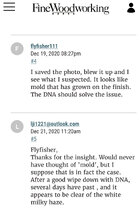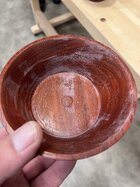 hi everybody. A member of our group here in Kelowna says he has a white film ( in the photo some of it has been wiped away) appearing on a couple of his bowls and is wondering if anyone might be able to explained. The bowls are made from Padauk (sp?) and the finish is wipe on poly. He uses exclusively wipe on poly and he’s made other bowls from the Padauk and he has not seen the film appear before. Is it the finish? Or the wood?
hi everybody. A member of our group here in Kelowna says he has a white film ( in the photo some of it has been wiped away) appearing on a couple of his bowls and is wondering if anyone might be able to explained. The bowls are made from Padauk (sp?) and the finish is wipe on poly. He uses exclusively wipe on poly and he’s made other bowls from the Padauk and he has not seen the film appear before. Is it the finish? Or the wood? -
December 2025 Turning Challenge: Single Tree! (click here for details) -
Congratulations to Bob Henrickson, People's Choice in the November 2025 Turning Challenge (click here for details) -
Congratulations to Guillaume Fontaine for "Old Tea Pot" being selected as Turning of the Week for December 15, 2025 (click here for details) -
Welcome new registering member. Your username must be your real First and Last name (for example: John Doe). "Screen names" and "handles" are not allowed and your registration will be deleted if you don't use your real name. Also, do not use all caps nor all lower case.
You are using an out of date browser. It may not display this or other websites correctly.
You should upgrade or use an alternative browser.
You should upgrade or use an alternative browser.
White film appearing after finish applied
- Thread starter John Leinemann
- Start date
My guess is that he used satin and the satin flattening agent wasn't thoroughly mixed in. But since you didn't give that data, as I say, just a guess. Lacquer can blush from trapping moisture under the finish, but wipe on poly sets up slow enough that is not an issue.
Unrelated to your question, but there is a guy local to me who turns bowls just like the one in your pic: BoardstoBowls. We mostly sell our wares in different venues so I've only met him once and didn't ask, but if you look at the link you will see numerous variations on that straight, outward-flared wall design with that plug in the flat bottom. Not really my taste, as I am all about chasing that elusive perfect curve; I am just curious about the technique. Is it started from the bottom on a screw chuck and then the hole is plugged?
I don't get it. When I use a screw chuck as I usually do with platters, I screw it onto the top of the blank, finish the bottom, then chuck it into the recess to turn out all evidence of the hole, but different strokes for different folks, I guess. Anybody want to weigh in on this technique?
I remember getting some cloudy stuff like that when I tried to wipe on oil in very humid conditions, so residual moisture could definitely be the culprit.
edit to add: I've turned my share of padauk (even though I hate its noxious orange dust!), and I've never had an issue with it taking a TruOil finish (which is basically a wiping varnish). I'm pretty sure it's not the wood.
I don't get it. When I use a screw chuck as I usually do with platters, I screw it onto the top of the blank, finish the bottom, then chuck it into the recess to turn out all evidence of the hole, but different strokes for different folks, I guess. Anybody want to weigh in on this technique?
I remember getting some cloudy stuff like that when I tried to wipe on oil in very humid conditions, so residual moisture could definitely be the culprit.
edit to add: I've turned my share of padauk (even though I hate its noxious orange dust!), and I've never had an issue with it taking a TruOil finish (which is basically a wiping varnish). I'm pretty sure it's not the wood.
Last edited:
That does make a lot of sense Richard… I’ll have to ask him what type he used. Appreciate the commentMy guess is that he used satin and the satin flattening agent wasn't thoroughly mixed in. But since you didn't give that data, as I say, just a guess. Lacquer can blush from trapping moisture under the finish, but wipe on poly sets up slow enough that is not an issue.
Hi Aaron. The system for making bowls like this is called a Ring Master. It’s an interesting set up. It’s not a lathe.Unrelated to your question, but there is a guy local to me who turns bowls just like the one in your pic: BoardstoBowls. We mostly sell our wares in different venues so I've only met him once and didn't ask, but if you look at the link you will see numerous variations on that straight, outward-flared wall design with that plug in the flat bottom. Not really my taste, as I am all about chasing that elusive perfect curve; I am just curious about the technique. Is it started from the bottom on a screw chuck and then the hole is plugged?
I don't get it. When I use a screw chuck as I usually do with platters, I screw it onto the top of the blank, finish the bottom, then chuck it into the recess to turn out all evidence of the hole, but different strokes for different folks, I guess. Anybody want to weigh in on this technique?
I remember getting some cloudy stuff like that when I tried to wipe on oil in very humid conditions, so residual moisture could definitely be the culprit.
edit to add: I've turned my share of padauk (even though I hate its noxious orange dust!), and I've never had an issue with it taking a TruOil finish (which is basically a wiping varnish). I'm pretty sure it's not the wood.
I have a Ring Master for my lathe (16"). They are supposed the have a hole in the bottom piece (as that is how it is held), But thanks to my good friend Jim Danbury my Ring Master bowls no longer have a hole in the bottom that has to be plugged. Jim used a 1 3/8" expanding collet chuck from Penn State Industries. It came with a 1 3/8" Forstner bit. You drill a 1 3/8" hole about a 1/4" deep and expand the collet into it. It has worked flawlessly for me. The bad part is that Penn State Industries no longer sells these (as I would love a backup).
I've had that issue with padauk. Nothing else.
I applied linseed oil and wax to it. It seems like the wax almost precipitates back out? Is padauk oily?
I applied linseed oil and wax to it. It seems like the wax almost precipitates back out? Is padauk oily?
Thank you, I will pass this on the my Club mate.I have a Ring Master for my lathe (16"). They are supposed the have a hole in the bottom piece (as that is how it is held), But thanks to my good friend Jim Danbury my Ring Master bowls no longer have a hole in the bottom that has to be plugged. Jim used a 1 3/8" expanding collet chuck from Penn State Industries. It came with a 1 3/8" Forstner bit. You drill a 1 3/8" hole about a 1/4" deep and expand the collet into it. It has worked flawlessly for me. The bad part is that Penn State Industries no longer sells these (as I would love a backup).
I personally don’t know… I haven’t worked with Padauk yet. Anyone else know more about this speciesI've had that issue with padauk. Nothing else.
I applied linseed oil and wax to it. It seems like the wax almost precipitates back out? Is padauk oily?
- Joined
- Feb 6, 2010
- Messages
- 3,454
- Likes
- 2,522
- Location
- Brandon, MS
- Website
- threeringswoodshop.square.site
I have two planks of Padauk in my shop . One is what we would call normal but the other has that white film. You can wipe it off but it does come back. This is unfinished wood. So from this I would say it has nothing to do with finish but is simply oxidation.
From what I’ve read you can sometimes get something that looks similar to this if the finish is applied in a damp environment.
I have been having a similar issue with a small padauk turning I made. I haven't applied any finish yet, but it's getting a white haze. It wipes off easily, and like you said always seems to return. I was hoping that finish would resolve the issue. Sounds like from other responses, the finish would not be the solution.I have two planks of Padauk in my shop . One is what we would call normal but the other has that white film. You can wipe it off but it does come back. This is unfinished wood. So from this I would say it has nothing to do with finish but is simply oxidation.
I personally don’t know… I haven’t worked with Padauk yet. Anyone else know more about this species
I've turned Padauk. I'm not a big fan. The color is nice at first.
The Wood Database website lists it as one of the Top Ten Overrated Woods:
Top Ten Most Overrated Woods | The Wood Database
African Padauk | The Wood Database (Hardwood)
However, I disagree with a few of those in Eric's list. Specifically, wood from different trees can vary widely. And much may, as usual, depend on what you turn and how it's finished. For example:
- I have some Purpleheart that simply refuses to turn brown. A friend from South America is amazed at the popularity of Purpleheart in the US. He said they use it for things like floor joists.
- I find Bloodwood a joy to turn, especially small things - fine grain, good surface off the tool, great for finials and such. Some has stayed wonderfully red for a decade. Maybe it's the specific wood, maybe the finish. I have some big pieces but I cut them up into small pieces.
- Polished black ebony is indeed nearly indistinguishable from black plastic. However, I look for pieces with brown streaks. Also, making it slightly "unpolished" with 0000 steel wool is better, IMO.
- I like the look of Ambrosia Maple.
Weird-I've never had this issue on padauk. I wonder why? And John-I thought everyone likes ambrosia maple. I try to keep a few pieces turned from it on my craft show table; it usually sells before anything else. I guess Eric is entitled to his wrong opinion.
I guess Eric is entitled to his wrong opinion.
Well, it's HIS opinion, anyway!
I've talked to Eric several times and he seems like a real nice guy. But this reminds me I told him I'd send him a sample of wood he doesn't have (a rare thing for a wood collector!) I completely forgot.
A good friend of mine made a beautiful elliptically-shaped table from Ambrosia Maple. The legs are held together with wooden pins. I gave him some pieces of black ebony for wedges.
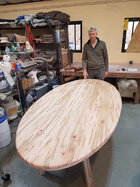
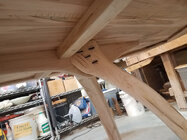
JKJ
Well, since we're already off-topic anyway, I just got in a box of curly ambrosia maple blanks from GotWoodLLC, with the plan being to have at least one bowl of it for each of my three tables and two vertical displays at upcoming shows. The curly ambrosia is one of my all-time favorite woods.
And I've said this before here: As I am just finishing up my 1st year doing local craft shows, I watch and study people and potential customers if they happen to wander over in order to learn what I can, what attracts buyers, etc. I especially watch how their eyes track because it really helps me learn how and what to market, how to best display it, etc. Time after time, I have watched people scanning my displays full of various domestic hardwoods and a few exotics, and then their eyes stop on the ambrosia maple. As often as not, if I put it in their hands and talk about how it develops in the wood, I make the sale. Most people have never actually seen or held it, and are just fascinated by the beetle holes and colorful patterns. And fun fact (at least for me): it is always women who buy it, while the men gravitate more towards walnut-I have no idea why. Just my 2 cents, and worth exactly what you paid for it.
Now back to the annoying white residue on padauk.
And I've said this before here: As I am just finishing up my 1st year doing local craft shows, I watch and study people and potential customers if they happen to wander over in order to learn what I can, what attracts buyers, etc. I especially watch how their eyes track because it really helps me learn how and what to market, how to best display it, etc. Time after time, I have watched people scanning my displays full of various domestic hardwoods and a few exotics, and then their eyes stop on the ambrosia maple. As often as not, if I put it in their hands and talk about how it develops in the wood, I make the sale. Most people have never actually seen or held it, and are just fascinated by the beetle holes and colorful patterns. And fun fact (at least for me): it is always women who buy it, while the men gravitate more towards walnut-I have no idea why. Just my 2 cents, and worth exactly what you paid for it.
Now back to the annoying white residue on padauk.
Thinking back on a horror story that Chris Hall told from early in his career, about some purpleheart that wasn’t properly kiln dried. The purpleheart in that story just kept oozing purple, and on a built-in desk piece for a client no less. That has me wondering: are the padauk samples with white residue mentioned here not properly/fully kiln dried?
No clue whether the stuff I have has been "properly" kiln dried. I've had the issue on one of the 2x4x4 padauk turning blanks from a woodworking supply store that have gotten the white haze, but the kiln dried 4/4 board and pen blanks I got from the other store have not presented the white haze issue. It could certainly come down to the level of kiln drying.
Also I'm trying the DNA wipe down to see if that resolves the issue before I apply finish.
Also I'm trying the DNA wipe down to see if that resolves the issue before I apply finish.
That has me wondering: are the padauk samples with white residue mentioned here not properly/fully kiln dried?
I agree, perhaps the wood had too much moisture.
A lot of purchased wood is not dry, either by kiln or air. I almost never turn wet wood.
I've bought a significant amt of wood directly from importers and it is almost always wet. I don't use any kind of kiln or forced drying, just air dry.
I assume all wood is wet until proven otherwise. I have moisture meters but more accurate is checking dryness by weight. I use a sensitive scale that reads in grams. Weigh the blank, write the date and weight on a piece of tape stuck to the side, then weigh again after a month or a few. If the weight decreases, repeat until the decrease levels out or starts going back up (from seasonal humidity changes.)
My shop wood including the storage areas has heat & air so the humidity doesn't change much.
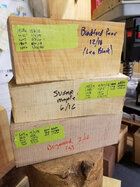
I usually have 100s of blanks of various sizes drying at any one time. I just track a typical blank of a typical size from a batch I've processed and seal on the ends. I track most expensive purchased exotic blanks, especially if not small and if covered with thick paraffin..
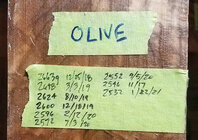
Blanks often take a while to dry. 2x2s in many species are pretty quick unless they they were covered by wax paraffin wax when wet. Then they can take a LONG time to dry. It that case, I let the blanks dry a for a few months then scrape off most of the wax with a card scraper and start the weight tracking. Large blanks can take years.
Remember that a 2x2 can air dry MUCH quicker than a larger blank (depending on species and more)
Another very accurate test can be done in a few hours but it does sacrifice a small piece of wood: The oven-dry method. Cut and remove a small sample away from the ends, weight it on a precise scale (I use a scale that measures to 0.01 gram), then heat it in an oven at a specified temperature. When the weight quita changing the sample is totally dry. Use the starting and final weights and a simple formula to calculate the moisture content of the original blank.
Moisture Content (%) = [(Wet weight - Dry weight) / Dry weight] * 100.
If the original blank is "dry", the calculated EMC should be between 9% and 15% depending on the environment in the storage. Area. This is a quick but may need some things: some kind of oven, a thermocouple and reader or good thermomenter to monitor the oven temperature, the precision scale.
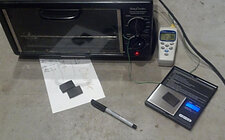
I did this test on one piece of a large batch of ebony that was covered with wax. It was dry.
The dealer said he usually waxes all wood as it comes in. Just because.
JKJ
I have had this issue with Padauk in the past. My theory is that it is caused by the oils in the Padauk interfering with the polymerization of the polyurethane. I have since abandoned the use of wipe-on poly on Padauk. I now use walnut oil followed by Beall buff. I get the same thing on other oily woods too.
Wouldn't weighing so many blanks and updating their weights take a long time, especially every month? Does it take hours to weigh them all?I assume all wood is wet until proven otherwise. I have moisture meters but more accurate is checking dryness by weight. I use a sensitive scale that reads in grams. Weigh the blank, write the date and weight on a piece of tape stuck to the side, then weigh again after a month or a few. If the weight decreases, repeat until the decrease levels out or starts going back up (from seasonal humidity changes.)
I usually have 100s of blanks of various sizes drying at any one time.
I mentioned "I just track a typical blank of a typical size from a batch". For example, If I cut 20 of 4x4 blanks from green cherry I'll just monitor one. I figure the others are going to dry about the same. If I also cut significantly larger or some a little smaller I'll check one of those too. I never bother with pen blanks for the club, since they dry so quickly.Wouldn't weighing so many blanks and updating their weights take a long time, especially every month? Does it take hours to weigh them all?
If unsure, of a particular blank I want to turn, I'll check it with a pinless moisture meter.
Also, I may only check every few months, or when I remember. If you look at dates on the blanks in the pictures some checks are 4 to 5 months apart. If I forget, it may be longer! If it's been a while, when I feel like it I'll set a scale on a wooden stool with a flat top and check all I see with green tape!
I've been drying wood like this for more than 15 years so I can almost always find a good dry piece! I seriously have too much wood. It's a sickness. This is only part of it, pictures from a few years ago. I have actually slowed down processing a little as I become elderly and feeble.
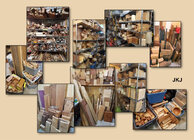
This reminds me - I need to pack some wood into boxes tomorrow - I finally picked up some flat rate boxes from the post office. It's been hectic here!
JKJ
Last edited:
- Joined
- Feb 6, 2010
- Messages
- 3,454
- Likes
- 2,522
- Location
- Brandon, MS
- Website
- threeringswoodshop.square.site
The plank I have has been in my shop for at least 8 years so I cannot see moisture as being the problem. Like JKJ said this wood was importerd in a container mixed with other wood. I wonder if there are some different species much like oak has so many.
Hmmmmm, looks like wood hoarders disease.
Hmmmmm, looks like wood hoarders disease.
Oh, I hope you didn't expect a one-line response!
I guess I could be a hoarder! But I think that definition might depend on what one does with the wood.
Maybe I have a wood lover's or dry wood turner's disease.
If I turned only green wood, unless I was a production turner like Glenn Lucas (ack!) it would be crazy to keep a lot on hand. And I really enjoy processing green into dry blanks, so it's a hobby in itself - one with lots of benefits.
Friends and students always have wood to turn, both for practice and to make things to take home. Just recently a new turner came and we made a tool handle from dry persimmon; another went home with a beautiful conductor's baton for his son, a combination of dry exotic and local wood.
What would these new turners have done without good dry wood to work with?! They started from scratch, never saw a lathe before. I offered a 1-day lesson on a whim. Spindles with a skew and spindle gouge in the morning, bowls after lunch. One is an active turner today.
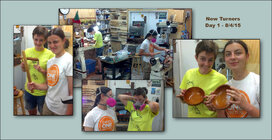
One friend wanted to make a cutting board to take to a new house at a new job. I had plenty of species and colors to design from - she picked bubinga, pau marfim, and strips of walnut from the flatwood stash. She's used it every day for years now.
When my Lovely Bride wants presents for friends I never go shopping for wood!
I usually donate 4-5 tubs of dry wood to our club wood auction, sometime cutting larger pieces into pen blanks - sets of a dozen pen blanks from exotic, burled, or distinctive colors always get good bids! I cut dry wood round for bowl blanks and flatten top/bottom with the drum sander so people can see to color and that they are defect free - I took some mahogany blanks like that last year. Even bags of "practice" wood sell for more than I expect. The high bid for a "Bag-O-Cherry" spindle-turning blanks surprised me last year.
Exotic woods are expensive and that could be a hoarder problem, but they are often wet and can take years to dry. I keep enough to have dry wood to pick from when I feel inspired. It's a good life!
When I or friends do demos I like to provide enough blanks so anyone who wants to try the project can go home with the wood. I've got a demo soon on handbell ornaments (timed to let people make them before Christmas) and I'll take enough blanks for both the bell and the handles for everyone, all cut to size to mount immediately on the lathe. Larger blanks I might auction off with the proceeds going to the club. Having the blanks in hand when they go home can make the difference between them trying the project or maybe THINKING about getting around to it later. On one handbell demo I took blanks and was amazed at how many people brought back an ornament the next month! Those who did got their pick of blanks from the "good" stash! Great fun!
BTW, by handbell ornaments I mean these, patterned after the larger metal handbells used in handbell choirs, but small enough to hang on the tree. Might look tricky but it's an easy project - I hollow with a parting tool. The handle has some deatil. (Scheduled for another demo on these in a couple of months)
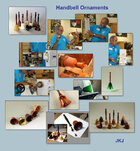
I do know some true wood hoarders. How about a turner with several rooms full, one room with cubby shelves from floor to ceiling on all four walls. Most are about 2x2 or so turning squares. It appears the person rarely turns, I've seen nothing to show&tell, doesn't teach, doesn't give away wood. Over 300 species the last I heard. Catalogs with a spreadsheet: every piece, species, size, cost, date. However, when I'm looking for a special piece he's glad to sell it! Almost like a turning wood store! It's all good.
I met another guy who had a huge pile of green wood that filled 1/2 his garage. He was unable to turn down any free green wood. He tried to give me some but it was all punky and horribly split and cracked from drying without any sealer. That was all bad. To be fair, he was a new turner and simply needed education.
I should mention there are true wood collectors, usually members of the International Wood Collectors Society. They keep pieces 3x6x1/2" for display, ID, trading. Eric at Wood Database is one.
But as I mention in my wood processing video, when I want to turn something it is SO wonderful to just pull the perfect piece off the shelf. Life is good.
JKJ
Last edited:
Since we are way off-topic, while I have found many ambrosia maple bowl blanks to be pretty blah in appearance and too soft for good turning, there can also be excellent ones. And for those (like Eric) who find ambrosia maple to be over-rated, this is an ambrosia maple table that I made for my cottage. Ambrosia maple can be entrancing.Well, since we're already off-topic anyway, I just got in a box of curly ambrosia maple blanks from GotWoodLLC, with the plan being to have at least one bowl of it for each of my three tables and two vertical displays at upcoming shows. The curly ambrosia is one of my all-time favorite woods.
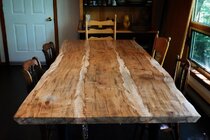
TWo days after wiping the pieces down with Denatured alcohol, one seems to be clear of hazing and the other has some minimal hazing only within the rim. It certainly helped, but might take a few tries to fully clear up.No clue whether the stuff I have has been "properly" kiln dried. I've had the issue on one of the 2x4x4 padauk turning blanks from a woodworking supply store that have gotten the white haze, but the kiln dried 4/4 board and pen blanks I got from the other store have not presented the white haze issue. It could certainly come down to the level of kiln drying.
Also I'm trying the DNA wipe down to see if that resolves the issue before I apply finish.
thanks for the link to the Wood Database article on color changes. Have been using WDB for years, online and the book, and don't remember reading it. Did an Osage Orange vase with pyrography that I was very proud of. Now 6 years later it's almost brown.I've turned Padauk. I'm not a big fan. The color is nice at first.
The Wood Database website lists it as one of the Top Ten Overrated Woods:
Here's their entry for African Padauk:Top Ten Most Overrated Woods | The Wood Database
www.wood-database.com
African Padauk | The Wood Database (Hardwood)
www.wood-database.com
However, I disagree with a few of those in Eric's list. Specifically, wood from different trees can vary widely. And much may, as usual, depend on what you turn and how it's finished. For example:
JKJ
- I have some Purpleheart that simply refuses to turn brown. A friend from South America is amazed at the popularity of Purpleheart in the US. He said they use it for things like floor joists.
- I find Bloodwood a joy to turn, especially small things - fine grain, good surface off the tool, great for finials and such. Some has stayed wonderfully red for a decade. Maybe it's the specific wood, maybe the finish. I have some big pieces but I cut them up into small pieces.
- Polished black ebony is indeed nearly indistinguishable from black plastic. However, I look for pieces with brown streaks. Also, making it slightly "unpolished" with 0000 steel wool is better, IMO.
- I like the look of Ambrosia Maple.

